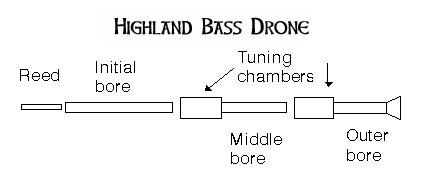
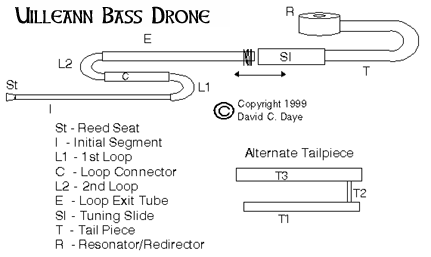
First update 26 November 2010 -- Full plot of hybrid added, and photo / notes on antique uilleann style artificial reed.
Here is a large slow-loading, minimally compressed and processed .wav file recorded in stereo through large diaphragm condenser mikes and a semi-pro USB digital sound mixer, 75 feet back outdoors, as I slowly rotated around. A smaller more compressed .mp3 file is here.
I've always wanted better bass sound than I've been able to get in my ordinary-quality Highland pipes or any that are regularly available, so after several years of working as a fulltime uilleann pipe maker with an excellent bass drone design, I decided to compare it to some Highland basses and see if the uilleann could inform some modifications to my Highland bass.


First a reminder of how the 2 drones are constructed. The Highland bass stands upright over the standing piper's shoulder with the reed at the bottom and is made of 3 segments in a straight line. The uilleann bass lies across the seated piper, and is looped around to save space. It has quite a few more components than the Highland, which various makers have exploited to lesser or greater degree for introducing complexity into the bore.
I compared uilleann and Highland basses by plotting them together, re-scaled to the same diameter and length ranges, to faithfully illustrate the proportions of each instrument. For this first look both bores are simplified with certain compexities of each omitted.
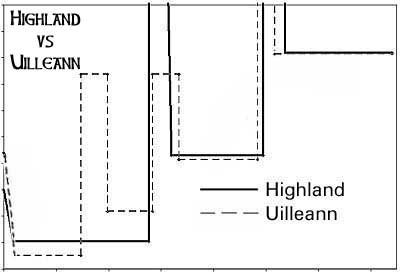 The
diagram has the reed seat end of the drones at left. The height of the
lines above the bottom indicates width of bores, and distance to the right
of the left edge indicates length along the bore toward the exit at the
end of the drones shown at right. The high rectangular bore segments represent
large expansions in the bore that are tone chambers. The Highland bass
has two very wide chambers whose plots go off this particular chart, which
are the two tuning slides. The uilleann has only one tuning slide, indicated
by the dashed segment near the right end that extends off the top of the
chart at about the same location as the Highland tuning slide. The other
2 shorter chambers at left on the uilleann plot are the brass tubing half-turns
that allow the bore to loop around to save space. In the particular case
of the Harringon make, unlike many uilleanns, these loops are much wider
than the bores on either side and so they function as expansion chambers.
The widths of the chambers on the plot line of course are their bore lengths,
and for this plot I used the lengths not as built but rather as measured
in practice when the slides are in their typical playing positions for
both instruments.
The
diagram has the reed seat end of the drones at left. The height of the
lines above the bottom indicates width of bores, and distance to the right
of the left edge indicates length along the bore toward the exit at the
end of the drones shown at right. The high rectangular bore segments represent
large expansions in the bore that are tone chambers. The Highland bass
has two very wide chambers whose plots go off this particular chart, which
are the two tuning slides. The uilleann has only one tuning slide, indicated
by the dashed segment near the right end that extends off the top of the
chart at about the same location as the Highland tuning slide. The other
2 shorter chambers at left on the uilleann plot are the brass tubing half-turns
that allow the bore to loop around to save space. In the particular case
of the Harringon make, unlike many uilleanns, these loops are much wider
than the bores on either side and so they function as expansion chambers.
The widths of the chambers on the plot line of course are their bore lengths,
and for this plot I used the lengths not as built but rather as measured
in practice when the slides are in their typical playing positions for
both instruments.
The particular pair shown above was a surprise.
The Highland is an alleged 1910 Henderson bore plot that I'd found on the web in the past. Some Hendersons of that era have a highly regarded bass with both a strong deep fundamental and also rich harmonics. The uilleann pipe was made in the 1850's by Harrington and is pitched approximately in B. Its bass drone is almost exactly an octave lower pitched than the Highland bass. The design is published in full detail in The Sean Reid Society Vol. 2 available from _Na Piobairi Uilleann_ in Dublin, Ireland. This bass has a tonal reputation in its world similar to the Henderson's reputation in the Highland world.
What struck me were a number of similarities between the the two that are evident in the plot above: the outer 2 bore segments have almost identical proportions, and the two Highland tuning slide chambers lie at about the same proportional distance along the bore as the 2nd and 3rd uilleann chambers. I have to wonder if the similarities may indicate something about the history of the development of both instruments.
Now, it's well known that in bores of particular instruments there can be some enhancements that contribute to especially good tone or performance, so there are always top players on the lookout for the best specimens. When I first built a prototype of the 1910 Henderson a number of years ago, I got much of the familiar power and bass fundamental, but the tone although clean wasn't especially inspirational. I presumed that whoever measured this instrument either missed some detail, deliberately simplified it, or only had a rather ordinary specimen available. So when I finally turned to the project of improving my own bass, I knew that simply replicating this Henderson was not all the improvement I needed.
Because of the similarities in tone and proportions of the two basses, I decided to experiment by adding features of this uilleann bass to the Highland to see if they could enrich its tone as I had found them through extensive testing to do in the uilleann bass.
To be able to experiment without the formidable time investment in custom made boring tools, I built a Henderson experimental "chassis" of my beloved thick-walled brass tubing for bores and plumbing pipe for tuning chambers, and that's the construction I'll detail shortly.
 To
make tenons for tuning, for mounting the lower drone section into the bag
stock, and for fitting the bottom ends of the 2 upper bore segments into
their plumbing pipe tuning slides, I simply wound lengths of electrical
tape onto the bore tubing and finished it with teflon tape. The 3/4"
I.D. PVC plumbing pipe used for tuning slides cracks easily under
the stresses of a Highland bagpipe, so they had to be reinforced with the
wrapping of black electrical tape you see above. The chassis' brass bore
is wider inside than the final internal diameters to allow for thick or
thin-walled tubes to be pushed inside to make the actual working acoustic
bores, and easily removed to be re-shaped or exchanged for testing.
To
make tenons for tuning, for mounting the lower drone section into the bag
stock, and for fitting the bottom ends of the 2 upper bore segments into
their plumbing pipe tuning slides, I simply wound lengths of electrical
tape onto the bore tubing and finished it with teflon tape. The 3/4"
I.D. PVC plumbing pipe used for tuning slides cracks easily under
the stresses of a Highland bagpipe, so they had to be reinforced with the
wrapping of black electrical tape you see above. The chassis' brass bore
is wider inside than the final internal diameters to allow for thick or
thin-walled tubes to be pushed inside to make the actual working acoustic
bores, and easily removed to be re-shaped or exchanged for testing.
The photo shows the segments laid out from the reed end at left to the upper bore segment at right. Since I'm now playing the drone for practice and in performances you can see the cords black-taped to the upper end of the bore at right. It's crude, but with tartan drone ribbons added, and the rest of the set traditional, it sufficies for many performances till I can reproduce my final design in wood.
Despite the many components needed to construct a long uilleann bass in a looped form compact enough for comfortable playing in the seated position, some of the earliest basses were internally as simple as Highland tenors: a long initial bore of one constant diameter, a wide tuning slide, and a shorter outer bore wider than the initial bore. But by the mid 1800's some makers, Harrington at least, were making use of every component as either bore or chamber, and adding further complexity in the form of tapers to some of the straight segments as well. Even though a few antique specimens survive to the modern era, understanding of some of these principles seems to have been lost. Modern uilleann basses in the louder, higher pitched common Concert D form are usually simpler and regarded by lovers of the antique instruments at least as having less appealing and noisier tone.
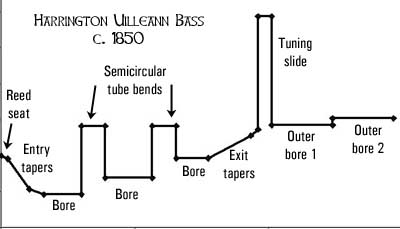 Here
is a complete plot of the original Harrington bass. Notice a lengthy entry
with two tapers after the reed seat that are not seen in Highland basses,
at least the everyday quality sets I've owned. The two semicircular tubing
bends are much wider inside than the bores on either side, which is usually
not the case with modern Concert D uilleann sets. The long piece from
the 2nd loop out to the tuning slide tenon has 2 more tapers covering more
than half its length, where modern Highlands often have a much shorter
and shallower taper leading into the upper slide. The length of the Harrington
tuning slide chamber as plotted above for its typical assembled length
when playing is shorter than a Highland bass's typical upper tuning chamber
length when playing. Finally, the outer bore segment has a stepped bore
of two equal lengths, and there is no chamber or resonator of any type
at the bell end of the Harrington. The ornament seen at the end of
this an other uilleann basses is often a simple redirection of the bore
forward toward listeners, maintaining the outer bore's diameter to the
end.
Here
is a complete plot of the original Harrington bass. Notice a lengthy entry
with two tapers after the reed seat that are not seen in Highland basses,
at least the everyday quality sets I've owned. The two semicircular tubing
bends are much wider inside than the bores on either side, which is usually
not the case with modern Concert D uilleann sets. The long piece from
the 2nd loop out to the tuning slide tenon has 2 more tapers covering more
than half its length, where modern Highlands often have a much shorter
and shallower taper leading into the upper slide. The length of the Harrington
tuning slide chamber as plotted above for its typical assembled length
when playing is shorter than a Highland bass's typical upper tuning chamber
length when playing. Finally, the outer bore segment has a stepped bore
of two equal lengths, and there is no chamber or resonator of any type
at the bell end of the Harrington. The ornament seen at the end of
this an other uilleann basses is often a simple redirection of the bore
forward toward listeners, maintaining the outer bore's diameter to the
end.
Reed data were not collected by those who measured the original Harrington, but I knew that unlike Highland drones, uilleann drones typically take reeds with wider bores than the initial bore they fit into. (In the case of this bore, that would refer to the final straight bore after the entry tapers.) When I build this drone scaled up to the wide Concert D format for my business, I use a reed bore some 15% wider than the first straight bore after the entry tapers. This may be part of the explanation for why a 100% faithful expansion of the pure Harrington design out to Highland diameters didn't maintain the tonal quality I get in the uilleann Concert D rendition. It was rich to the point of noisiness. Since this uilleann base is almost a full octave lower pitched than a Highland bass, I speculate that a brighter or richer tonal content may work at that low pitch that doesn't an octave higher. The reed if similarly enlarged would have almost a half inch bore which would be enormous. In any case a complete replica in Highland pipes requires the extra expansion chamber in the middle of what would be the lower bore piece, which can't be built with historic Highland pipe methods and materials.
In expanding the original Harrington narrow-bore B to modern uilleann concert diameters, and shrinking the lengths to the contemporary D pitch based on A-440, I experimented over a period of months with every feature of this drone. I found that every single feature colors the tone to some degree. Some of the features filter undesirable harmonics away, while others are used for exchanging deep fundamental tonal power with richness or brightness of harmonics. I didn't invest a similar amount of time analyzing the eventual Highland-uilleann hybrid, so this will doubtless be a subject of investigation by experimenters or makers who take the design farther if they find it interesting enough to pursue.
Following are first the homebuild version, and later a table of the intended calculated dimensions that the homebuild was designed to reproduce as closely as possible.
As I'm spending virtually all my energy with my uilleann pipe development, the Highland experiments were interrupted for months. At this point I'm not exactly sure which inner/lower bore piece was played on the recording at the time I had the best sound, and there was a problem with the custom artificial reed I'd been using. While I'm sorting out the details I'll give the different inner bore details so you experimenters can get to work. It's only a matter of diameters; the lengths I know for certain. The "chassis" shell for the inner/lower bore piece is the same either way, it's only a matter of swapping in the final tubing bits.
The mounting tenon can be 3/4" wood dowel or plastic rod drilled out to glue onto the bottom end of the lower bore piece. This will be slightly small for a Highland bass stock, so a bit of hemping or a few wraps of electrical tape finished with teflon tape will suffice. A bit of enlargement can be put at the upper end of this, either turned, glued or more wrapped tape, to stop the part from sliding too far into the stock.
The 2 tuning slide parts are made from PVC or CPVC plumbing pipe sold in the US at nominally 3/4" I.D.. It's actually a bit undersized at around 0.70" I.D.. So to mount the following bore tube into the pipe slides, you can turn a mounting piece from 3/4" wood or plastic stock and drill it to accept the tubing if you have a lathe, or glue a number of wider brass tubes on the bottom of the bore tube to increase the diameter, and finish off with a wrapping of electrical tape to get a snug fit. I found that a firm tight wrapping of several layers of electrical tape was needed around the PVC pieces to strengthen them against cracking under the stresses of handling, especially the lower slide which carries some of the stress of the cords holding the 2 tenor drones.
The working bores are made with variously thickwall (.029") or thinwall (.014") brass tube pieces pushed into position inside the chassis bores. The tube is sold according to outside diameters, in 1/16" increments for the thickwall and 1/32" increments for thinwall. The inside diameters are nominally the next fractional size less than the outside diameters, but a small clearance factor for ease of telescoping makes the actual inside diameters about .003" wider than the nominal fraction size for the thickwall and .002" wider for the thinwall, as I calculate them. So for examples, a 3/8" thickwall tube will have an inside diameter of 1/16" less, plus .003", or 5/16" +.003" for 0.3155". A 3/8" thinwall tube will be 1/32" less, plus .002", or 0.3458".
1/32" steps can be made in the thickwall, and 1/64" steps in thinwall, by cutting tube lengthwise in half. Tapers are made by cutting tubing at a long narrow angle.
I stopped competing on Highland pipes in the mid 1980's to concentrate on folk band, entertainment and Highland dance piping. Since this involved occasional playing with organs or other concert instruments, I set up my instrument at concert B-flat pitch. This drone is also proportioned for B-flat but it can be scaled greatly to other pitches though, from A-440 for folk bands up to any modern competition pitch into the 480's and beyond.
With my home built artificial drone reed on a natural cane body, and tuning slides set at the conventional Highland depths when playing, I measured my original B-flat personal bass at around 840 mm overall bore length (not including the reed). So I rescaled the 1910 Henderson Highland and the 1850 Harrington uilleann basses to the same length to begin the experimentation. After the various enhancements yielded a flatter pitch, I arrived at a working assembled bore length of 741 mm for this concert B-Flat hybrid.
I was able to divide the construction into the familiar 3 segments of the Highland bass, but the proportions are somewhat different. Also there is no chamber of any kind at the end of this bass, so it would be difficult to simply convert an existing Highland bass to this configuration. All the segment length proportions are taken from the uilleann, as are most of the bore diameters with a few exceptions that I'll note.
It should not need reminding but it is completely unethical to rebore an irreplaceable historic instrument. Do your experimenting with the brass plastic and if you must bore something, use a 3rd world knockoff. Keep hands off antique pipes except for cleaning, repairing cracks and mounts, and reversible alterations such as narrowing the effective bore by inserting removable wires or sleeves that don't scrape wood.
This is what you're aiming for. The diameters all show slightly greater than nominal 1/32" or 1/16" stepped sizes because the exact inside diameter of the brass tubing includes a clearance factor I estimate at +.002" for the thinwall brass and .003" for the thickwall. The initial step of the final outer bore is shown below the 35/64" diameter line because that's the exact proportion from the Harrington, scaled up of course, and the piece is made by slicing a thinwall tube in half so cutting a hair less than halfway would be about that size.
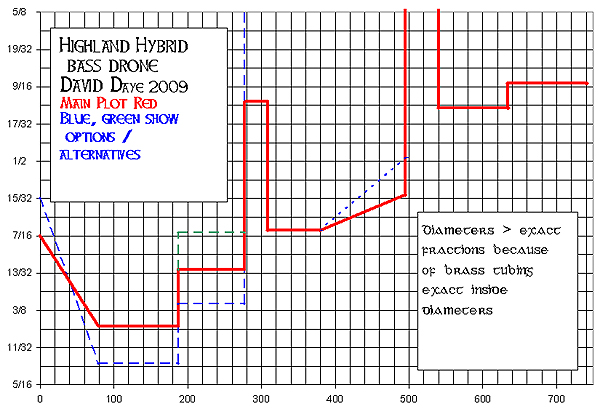
All the experimenting I did used this chassis so this will work regardless of the exact inner bore I eventually confirm.
|
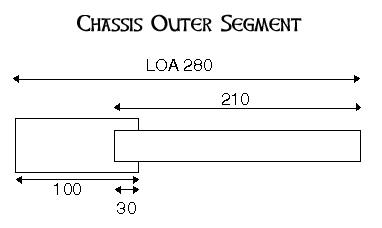 |
|||||||||||||||
|
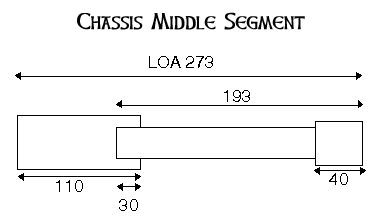 |
|||||||||||||||
|
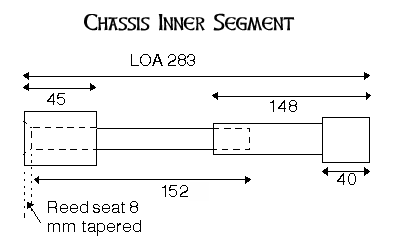 |
|
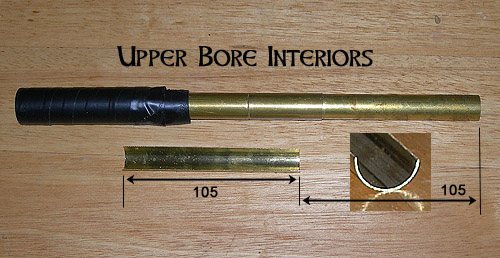 |
||||||||||||||||||||
|
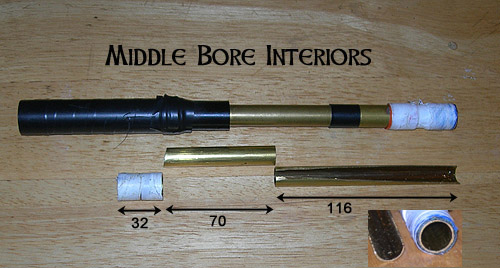 |
||||||||||||||||||||
|
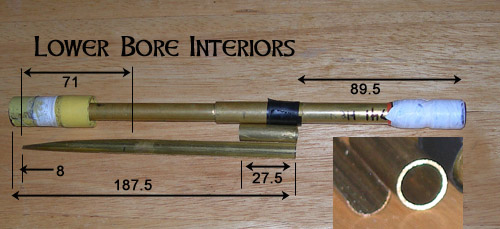 |
The inner diameters are where my temporary uncertainty is. The length and step position are solid, and the expansion step at 187.5 mm seems to be a sweet spot for some pleasing harmonics. The long tapered entry is also important. The 4 choices for diameter sets are:
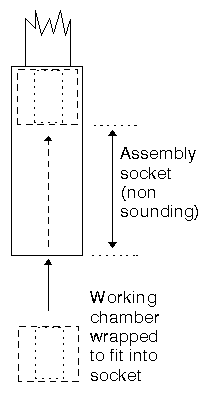 Again,
the lower "Assembly Socket" on this drone, where a traditional
Highland lower tuning slide would be, is for mechanical assembly only.
The tenon of the lower segment is intended to be pushed all the way in
against the narrower "Chamber" that begins 78 mm inside. Tuning
on this drone is done only with the upper slide. Obviously the exact length
of the lower 78 mm of socket is quite optional since it's purely structural
and is never moved for tuning.
Again,
the lower "Assembly Socket" on this drone, where a traditional
Highland lower tuning slide would be, is for mechanical assembly only.
The tenon of the lower segment is intended to be pushed all the way in
against the narrower "Chamber" that begins 78 mm inside. Tuning
on this drone is done only with the upper slide. Obviously the exact length
of the lower 78 mm of socket is quite optional since it's purely structural
and is never moved for tuning.
The tapers at the beginning of the bore are in a zone
of bore where, as with the reed, a widening creates a flattening or lowered
pitch. Since the original uilleann bass is a full octave below a Highland
bass, its length is great, so the tapers may originally have been for sheer
practicality of reducing the length of the drone a bit. However when I
tested them in developing my uilleann drone, I found they also added a
richness or sweetness to the tone. The drone was very boomy in the deep
fundamental without them, and as the tapers were widened, some of the deep
boom was exchanged for pleasing lower harmonics.
I felt that the Highland hybrid gained noticeable overall power when the
straight bore ending the lower segment was reduced slightly but I'm temporarily
uncertain what the starting point had been. In any case that's one thing
to look for in experimenting with the lower bore.
It's not possible using historic Highland construction to reproduce the chamber - bore - chamber format of the middle portion of the uilleann bass. But since the comparison layout shows that the uilleann's short connecting bore between the 1st and 2nd brass bend chambers is an expansion from the initial bore, and the 2nd bend lies at about the position of the Highland lower tuning chamber, I tested replicating the connecting bore stepup in the lower segment of the Highland bass chassis. At the position of the Highland lower tuning chamber I tested both wide chambers close to Highland standards, and a much narrower scaled uilleann chamber size. My subjective impression, not an especially firm one, is that the wider Highland chamber kills some of the tonal appeal.
I had a fairly strong impression that the step-up in the initial bore strengthens some of the octave or "A" harmonics, possibly in exchange for some of the "E" harmonic content the bass might have. The step position doesn't line up exactly with any of the uilleann bore change positions. It's something I found by experimenting and seemed to be a sensitive position for triggering some appealing tone.
The middle drone segment ends up noticeably shorter than standard for Highland basses. The long wide tapers at the end of the middle bore segment in both instruments seem to give away some deep bass fundamental power in exchange for an appealing brightness that is part of carrying a rich sound to listeners at some distance away. The full extent of the uilleann bass's taper was too much for my taste in the Highland, so I settled on a narrower taper. This is a tradeoff that I feel can be a matter of personal taste and application, for example solo vs band or indoor vs outdoor playing.
The slightly narrower initial half of the outer bore segment also seemed to me to add some sweetness and appeal to the tone.
The biggest surprise to me was the effect of the chalice-shaped Highland end-chamber. Before contemplating what a home builder might use to create an accurate replica of the Henderson bass chamber, I made up tooling to build an exact replica for my testing purposes. Every variation I tried from Henderson or other Highland basses noticeably damaged the tone, replacing a number of the more appealing harmonics with dull diffuse white noise. So I left the top end of this hybrid with a simple termination of the bore and no chamber or cap etc. as is the case with the Harrington uilleann. Experimenters may have different opinions about this.
Since every feature of this drone dates to either the Henderson era or the 1850's uilleann bass, it's not really a "new" design at all. My contributions to it are modest other than the innovation of attempting the hybrid in the first place, and omitting the part of the initial bore segment that equates to the uilleann brass bend that can't be built with traditional Highland methods.
My overall impression is that it's the strongest bass drone I've ever played, and has a great deal of power in the deepest bass fundamental. The sound is very clean compared to what I've been playing, to the point that it might be possible for the instrument to carry a louder bass drone than it ever has historically.
The taper leading into the upper tuning slide can be widened to gain brightness at a slight sacrifice of deep fundamental. Harrington proportions would widen it to 17/32" (9/16" O.D. thinwall tube) which I felt was too much in the Highland octave, or 1/2" might be more appealing to some.
I use a home made cane-artificial hybrid, a natural cane tube to get more cane tone in the slap-sound of the tongue instead of the plastic-on-plastic clicking, with a weighted .020" thick styrene plastic tongue. The Harrington like many antique narrow bore uillleann drones gets some deep purring tonality and richer deep harmonics by using weight on the tongue. Mine is a small piece of cane about 1/2 to 1 mm square across the width of the end of the tongue. The reed bore is probably noticeably wider than a modern contest reed and that would definitely affect tone.
Reed 110 mm outside length, about 107 mm bore length. I.D. 1/4", tongue free length about 18 mm.
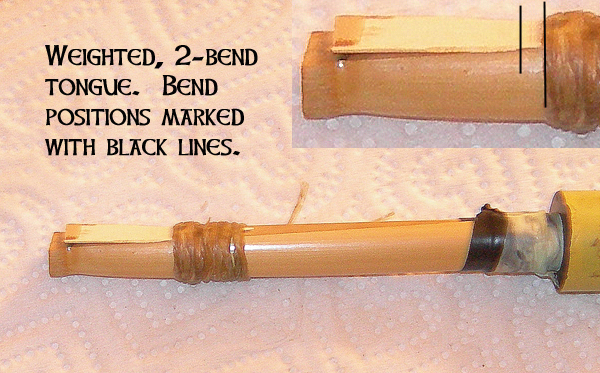
As indicated, the reed uses the 2-bend geometry numerous uilleann pipers and makers have found lets a home built plastic tongue behave exactly as traditional cane, the same strike-in double tone with unsteady loud low pressure mode and the yodle into the smooth steady mode just below chanter pressure.
Since the rise to 480 pitch has been done to a great extent with reeds, it's possible that this drone will play contest pitch as-is using a modern commercial drone reed.
I think however the weighted tongue is fairly important to getting a good sound out of this --it certainly is in the uilleann pipe. The drone or drone plus reed can be stretched or shrunk to play at A440 folk music pitch or up to contest pitch.
The bore diameters would be rescaled by a small fraction to equate to a 14 mm inside diameter bore after the step in the upper segment. All the straight and tapered bore segments would be multiplied by this same factor. The tuning chamber diameters are probably not critical; the upper slide is given as 18 mm for the Henderson, while the lower slide that is not really used in this version except for mounting purposes was 19 mm.
More detail will come over following weeks.
Bottom of New Highland Bass Drone page.